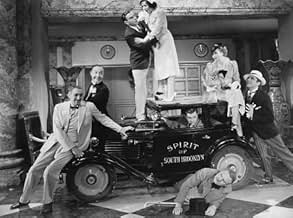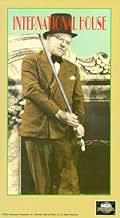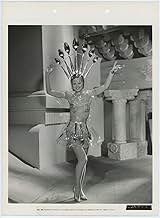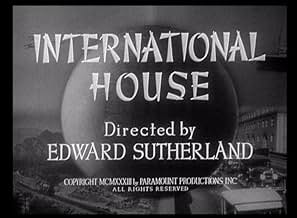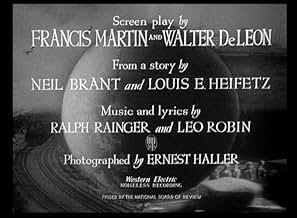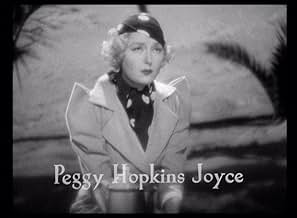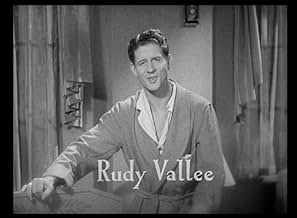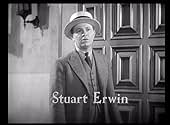IMDb रेटिंग
6.9/10
1.5 हज़ार
आपकी रेटिंग
अपनी भाषा में प्लॉट जोड़ेंAssorted wacky characters converge on a Chinese hotel to bid on a new invention: television.Assorted wacky characters converge on a Chinese hotel to bid on a new invention: television.Assorted wacky characters converge on a Chinese hotel to bid on a new invention: television.
Rose Marie
- Rose Marie
- (as Baby Rose Marie)
फ़ीचर्ड समीक्षाएं
International House (1933)
*** 1/2 (out of 4)
An all-star cast is the highlight of this comedy about a wacky group of characters who go to a Chinese hotel to bid on a new invention (the television). With a cast that includes W.C. Fields, Peggy Hopkins Joyce, Stewart Erwin, George Burns, Gracie Allen and Bela Lugosi, there's really something here for everyone. The film is certainly uneven but that's not really a problem since the movie is just set up to gets laughs at any way possible. I'm really not that big of a fan of Fields but I enjoyed his performance here. Burns and Allen certainly steal the show but I felt Lugosi gave one of his best performances here as well.
*** 1/2 (out of 4)
An all-star cast is the highlight of this comedy about a wacky group of characters who go to a Chinese hotel to bid on a new invention (the television). With a cast that includes W.C. Fields, Peggy Hopkins Joyce, Stewart Erwin, George Burns, Gracie Allen and Bela Lugosi, there's really something here for everyone. The film is certainly uneven but that's not really a problem since the movie is just set up to gets laughs at any way possible. I'm really not that big of a fan of Fields but I enjoyed his performance here. Burns and Allen certainly steal the show but I felt Lugosi gave one of his best performances here as well.
Early form of television that doesn't need a broadcast station brings people from all over the world to Wu Hu China with the hopes of buying it. Among those at the hotel guests are George Burns and Gracie Allen (as the hotel doctor and nurse), Bela Lugosi as a Russian General, WC Fields as a mad Professor, Frank Pangborn as the Hotel manager, and Sterling Halloway. While through the magic of TV we see Rudy Vallee, Rose Marie and Cab Calloway (who performs Reefer Man).
Wild comedy that is the sort of big budget multi star film that could only have been made in the studio system. Tighter story wise than many of the films of this sort its really more an excuse to have Burns and Allen and WC Fields be very funny for just over an hour. The jokes come along at a good clip, and since this is really pre-code they are often shaded slightly blue. To be certain the Burns and Allen stuff is close to being a cliché form of their routine, but its still funny. Fields arrival by auto-gyro heralds the arrival of Fields as a comic force to be reckoned with, as the film ceases to be about nothing so much much as Fields running over everyone and everything.He's a hysterical. Also amazing is Bela Lugosi in a rare comic turn. Bela plays it straight and his slow burn is funny enough that he clearly in the running with Edgar Kennedy as the man with the best one in Hollywood. He's so good at being silly one can't help but wish he had never made Dracula and been typecast as such.
This is a real gem.
Wild comedy that is the sort of big budget multi star film that could only have been made in the studio system. Tighter story wise than many of the films of this sort its really more an excuse to have Burns and Allen and WC Fields be very funny for just over an hour. The jokes come along at a good clip, and since this is really pre-code they are often shaded slightly blue. To be certain the Burns and Allen stuff is close to being a cliché form of their routine, but its still funny. Fields arrival by auto-gyro heralds the arrival of Fields as a comic force to be reckoned with, as the film ceases to be about nothing so much much as Fields running over everyone and everything.He's a hysterical. Also amazing is Bela Lugosi in a rare comic turn. Bela plays it straight and his slow burn is funny enough that he clearly in the running with Edgar Kennedy as the man with the best one in Hollywood. He's so good at being silly one can't help but wish he had never made Dracula and been typecast as such.
This is a real gem.
I've always wanted to use the word 'melange' in a review and here I finally have done it. That word is appropriate because this film is jam-packed with a wide variety of items--like a chef salad of films! There's a lot of comedy with W.C. Fields as well as Burns and Allen, romance with Stu Erwin and his sweetie, a jealous ex-husband (Bela Lugosi) and a lot of special appearances by radio stars (such as Baby Rose Marie--the same lady who later starred on "The Dick Van Dyke Show") and Cab Calloway--singing the ultra-bizarre "Reefer Man"--a film that makes fun of pot smoking! Yes, I did mean marijuana! This Pre-Code film has a lot of racy material other than the film--such as plenty of double-entendres by Fields, cohabitation and a song and dance number with surprisingly scantily clad ladies. Only a year later, after a tougher Production Code was enacted, much of this film simply wouldn't have been allowed--it just wasn't "proper family entertainment" according to the Hays Office (which is lampooned in a comment by Fields late in the film).
In many ways, the film is like a variety show and the plot really is rather irrelevant, though it is interesting to see such an early film talk about and supposedly demonstrate television. With so much variety in the film, many of the segments fall a bit short, but since they come and go so quickly, you're bound to be entertained only a moment later. Not great entertainment, but clearly an important film for lovers of classic cinema.
In many ways, the film is like a variety show and the plot really is rather irrelevant, though it is interesting to see such an early film talk about and supposedly demonstrate television. With so much variety in the film, many of the segments fall a bit short, but since they come and go so quickly, you're bound to be entertained only a moment later. Not great entertainment, but clearly an important film for lovers of classic cinema.
Paramount had the brilliant idea of featuring radio in the movies the previous year with The Big Broadcast. That film featured all kinds of radio stars the public only imagined and had an anarchic plot similar to International House.
I've often wondered if Paramount didn't mean to have this be The Big Broadcast of 1933 originally. Repeating from the cast of The Big Broadcast are Stu Erwin and Burns & Allen and Cab Calloway. Adding to the general hilarity are W.C. Fields, Franklin Pangborn, Rudy Vallee, Bela Lugosi, and the Paris Hilton of her day, Peggy Hopkins Joyce.
The slender thread of a plot this movie hangs on involves a Chinese inventor Edmund Breon who invents the seeing eye, radio you can see as well as listen to. Everyone wants to get their hands on this valuable patent. A lot of the musical guest stars get hooked into the film via the inventor testing out the device.
Bing Crosby made his feature film starring debut in The Big Broadcast and I wonder why his crooning rival Rudy Vallee was hired for this film. Rudy has a nice, but unmemorable number.
Of course what makes the film really go are Burns and Allen and W.C. Fields. They uplift any film they are in. George and Gracie's montypythonesque type dialog is timeless and priceless.
So is Fields of course, the eternal misanthrope. There was one bit of humor I caught in International House though that is rather dated. During that final chase scene through the International House lobby with Fields in an automobile, he pokes his head through the car roof and puts his top hat on. He then remarks something about this car used to belong to the Postmaster General.
As it turns out Herbert Hoover's Postmaster General was a rather fatuous gentlemen named Walter Brown. He liked to wear high silk hats and had a limousine designed with an extra tall roof so he could ride with his topper on. At government expense of course in the middle of the Depression. He was forever derided as High Hat Brown after that and even a year later after Hoover was out of office, W.C. Fields could wring a laugh or two with that crack from the Depression audience.
Still though, this should really be called The Big Broadcast of 1933.
I've often wondered if Paramount didn't mean to have this be The Big Broadcast of 1933 originally. Repeating from the cast of The Big Broadcast are Stu Erwin and Burns & Allen and Cab Calloway. Adding to the general hilarity are W.C. Fields, Franklin Pangborn, Rudy Vallee, Bela Lugosi, and the Paris Hilton of her day, Peggy Hopkins Joyce.
The slender thread of a plot this movie hangs on involves a Chinese inventor Edmund Breon who invents the seeing eye, radio you can see as well as listen to. Everyone wants to get their hands on this valuable patent. A lot of the musical guest stars get hooked into the film via the inventor testing out the device.
Bing Crosby made his feature film starring debut in The Big Broadcast and I wonder why his crooning rival Rudy Vallee was hired for this film. Rudy has a nice, but unmemorable number.
Of course what makes the film really go are Burns and Allen and W.C. Fields. They uplift any film they are in. George and Gracie's montypythonesque type dialog is timeless and priceless.
So is Fields of course, the eternal misanthrope. There was one bit of humor I caught in International House though that is rather dated. During that final chase scene through the International House lobby with Fields in an automobile, he pokes his head through the car roof and puts his top hat on. He then remarks something about this car used to belong to the Postmaster General.
As it turns out Herbert Hoover's Postmaster General was a rather fatuous gentlemen named Walter Brown. He liked to wear high silk hats and had a limousine designed with an extra tall roof so he could ride with his topper on. At government expense of course in the middle of the Depression. He was forever derided as High Hat Brown after that and even a year later after Hoover was out of office, W.C. Fields could wring a laugh or two with that crack from the Depression audience.
Still though, this should really be called The Big Broadcast of 1933.
Although he's on the screen for only half the time this is classic early Fields. Before he became the put upon family man he was this obnoxious but nevertheless hilarious blustering boasting egomaniac. Perfect scene with him and Gracie Allan. Fields is at his nastiest best here- "what is the penalty for murder in China?" Gracie Allan is equally funny with George Burns impeccable as her comedy foil. I loved the line about not telling where she went to school.. There are other highlights as well.Skip the stupid romance and most of the Peggy Hopkins Joyce scenes but enjoy the pre-code sexiness, particularly in the Tea-Cup number and Fields comment after looking in a key hole at the hotel. A fast wild ride a'la 30's comedy and not to be missed by fans of the genre.
क्या आपको पता है
- ट्रिवियाDuring the filming of one of W.C. Fields' scenes, a mild earthquake struck Los Angeles. The earthquake was supposedly captured on film. In the film clip, Fields and his co-stars are standing in the hotel lobby set, when the picture begins to shake as if the camera is vibrating. A chandelier on the set begins to swing back and forth, and a lamp suddenly falls over. Fields calmly ushers his co-stars off the soundstage, telling them to stay calm and walk slowly. The "earthquake footage" of Fields was played in newsreels across the country in the weeks following the 1933 quake. Nearly forty years later, however, director A. Edward Sutherland admitted that the "earthquake footage" was a hoax concocted by himself and Fields. It was done by rigging wires on the lamp and chandelier, and shaking the camera to simulate an earthquake. Sutherland claimed that he and Fields were amazed when the "earthquake footage" was accepted as genuine by newsreel distributors. "We shared a big laugh and an even bigger drink", Sutherland recalled. To this day, the fake "earthquake footage" is occasionally broadcast and accepted as genuine by entertainment television shows such as Access Hollywood (1996). The footage appeared in Hollywood Out-takes and Rare Footage (1983).
- गूफ़During the scene where Prof. Henry R. Quail is by his auto gyro talking to Doctor Wong and Peggy Hopkins Joyce, you can see the shadow of the boom mic moving above their heads. The boom mic then hits something, presumably the auto gyro, making a noise which makes Prof. Henry R. Quail and Peggy Joyce look up.
- भाव
Professor Quail: Hey! Where am I?
Woman: Wu-Hu.
Professor Quail: Woo-Hoo to you sweetheart. Hey Charlie, where am I?
Hotel Manager: WU-HU!
[Professor Quail removes the flower from his lapel]
Professor Quail: Don't let the posey fool you!
- कनेक्शनFeatured in Oops, those Hollywood Bloopers! (1982)
- साउंडट्रैकShe Was a China Tea-cup and He Was Just a Mug
(1933) (uncredited)
Lyrics by Leo Robin
Music by Ralph Rainger
Sung offscreen by an unidentified man and danced by Sterling Holloway, Lona Andre,
Mary Jane Sloan, Gwen Zetter and Chorus
टॉप पसंद
रेटिंग देने के लिए साइन-इन करें और वैयक्तिकृत सुझावों के लिए वॉचलिस्ट करें
- How long is International House?Alexa द्वारा संचालित
विवरण
- चलने की अवधि1 घंटा 8 मिनट
- रंग
- पक्ष अनुपात
- 1.37 : 1
इस पेज में योगदान दें
किसी बदलाव का सुझाव दें या अनुपलब्ध कॉन्टेंट जोड़ें



